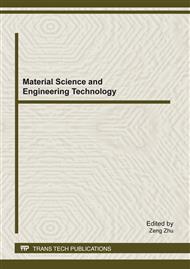[1]
D. Fox, J. Ko, K. Konolige, B. Limketkai, D. Schulz, and B. Stewart, Distributed multirobot exploration and mapping, Proceedings of the IEEE, vol. 94, no. 7, 2006, p.1325–1339.
DOI: 10.1109/jproc.2006.876927
Google Scholar
[2]
B. Yamauchi, Frontier-based exploration using multiple robots, Proceedings of the International Conference on Autonomous Agents, 1998, pp.47-53.
DOI: 10.1145/280765.280773
Google Scholar
[3]
W. Burgard et al., Collaborative multi-robot exploration, Proceedings of the International Conference on Robotics and Automation, vol. 1, 2000, pp.476-481.
Google Scholar
[4]
W. Burgard, M. Moors, C. Stachniss, F. Schneider, Coordinated multi robot exploration, IEEE Transactions on Robotics, vol. 21, no. 3, 2005, pp.376-386.
DOI: 10.1109/tro.2004.839232
Google Scholar
[5]
D. Latimer, et al, Towards sensor based coverage with robot teams, IEEE International Conference on Robotics and Automation, 2002, pp.961-967.
Google Scholar
[6]
B. Yamauchi, Decentralized coordination for multirobot exploration, Robotics and Autonomous Systems, Vol. 29, 1999, pp.111-118.
DOI: 10.1016/s0921-8890(99)00046-9
Google Scholar
[7]
S. S. Ge, C. H. Fua, Complete Multi-Robot Coverage of Unknown Environments with Minimum Repeated Coverage, IEEE International Conference on Robotics and Automation, 2005, pp.727-732.
DOI: 10.1109/robot.2005.1570202
Google Scholar
[8]
A. Howard, M. J. Mataric and G. S. Skhatme, Mobile sensor network deployment using potential fields: a distributed, scalable solution to the area coverage problem, 6th Int. Symp. on Distributed Autonomous Robotics Systems, 2002, pp.299-308.
DOI: 10.1007/978-4-431-65941-9_30
Google Scholar
[9]
A. Solanas, M. A. Garcia, Coordinated multi-robot exploration through unsupervised clustering of unknown space, Proc. Int. Conf. on Intelligent Robots and Systems, vol. 1, 2004, pp.717-721.
DOI: 10.1109/iros.2004.1389437
Google Scholar
[10]
Ling Wu, et al, Balanced Multi-Robot Exploration through a Global Optimization Strategy, Journal of Physical Agents, vol. 4, no. 1, (2010).
Google Scholar
[11]
J.A. Hartigan and M.A. Wong, A k-means clustering algorithm, Journal of Applied Statistics, vol. 28, 1979, pp.100-108.
Google Scholar
[12]
http: /www. computerrobotvision. org/slam_camp/ufkes_PathfindingTutorial. pdf.
Google Scholar
[13]
Anupam Shukla, Ritu Tiwari, Rahul Kala, Real Life Applications of Soft Computing, CRC Press Taylor & Fransis Group, (2010).
Google Scholar
[14]
H.W. Kuhn, The hungarian method for the assignment problem, Naval Research Logistics Quarterly, vol. 2, no. 1, 1955, p.83–97.
DOI: 10.1002/nav.3800020109
Google Scholar
[15]
H. Choset, Coverage for robotics—a survey of recent results, Ann. Math. Artif. Intell., vol. 31, no. 1, 2001, p.113–126.
Google Scholar
[16]
J. Rogge, D. Aeyels, A novel strategy for exploration with multiple robots, Proceedings of the 4th International Conference on Informatics in Control, Automation and Robotics, Angers, (2007).
Google Scholar
[17]
M. Al-Khawaldah, S. Livatino, D. Lee, Frontier based exploration with two Cooperative Mobile Robots, International Journal of Circuit, Systems and Signal Processing, Issue 2, Vol. 4, (2010).
DOI: 10.1109/isie.2010.5637085
Google Scholar
[18]
A. W. Stroupe, R. Ravichandran, T. Balch, Value-based action selection for exploration and mapping with robot teams, Proc. of the IEEE Int. Conf. on Robotics & Automation (ICRA), p.4090–4197, (2004).
DOI: 10.1109/robot.2004.1308930
Google Scholar
[19]
M. J. Matari´c, G. Sukhatme, Task-allocation and coordination of multiple robots for planetary exploration, Proc. of the Int. Conf. on Advanced Robotics (ICAR), p.61–70, (2001).
Google Scholar
[20]
R. Menezes, F. Martins, F. E. Vieira, R. Silva, M. Braga, A model for terrain coverage inspired by ant's alarm pheromones, Proceedings of the 2007 ACM symposium on Applied computing, 2007, p.728–732.
DOI: 10.1145/1244002.1244164
Google Scholar
[21]
Kai M. Wurm, et al, Coordinated Multi-robot Exploration using a Segmentation of the Environment, International conference on Intelligent Robots and Systems, (2008).
DOI: 10.1109/iros.2008.4650734
Google Scholar


